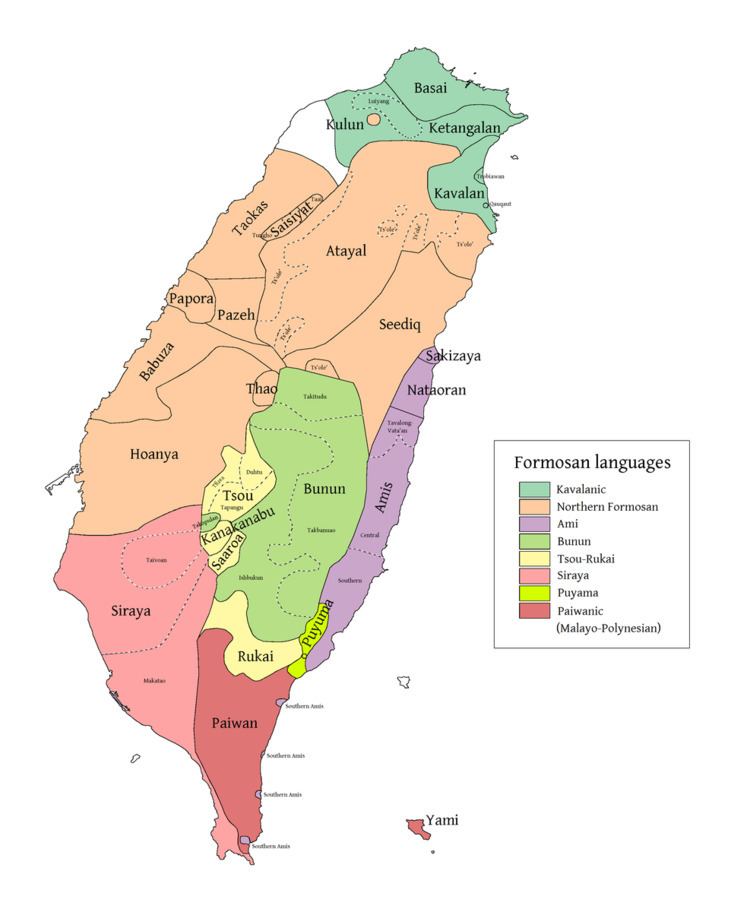Native speakers 180,000 (2009) Glottolog amis1246 | Ethnicity Ami ISO 639-3 ami | |
 | ||
Language family AustronesianEast FormosanAmis | ||
Amis is the Formosan language of the Amis (or Ami), an indigenous tribal people living along the east coast of Taiwan (see Taiwanese aborigines). Currently the largest of the Formosan languages, it is spoken from Hualien in the north to Taitung in the south, with another population near the southern end of the island, though the northern varieties are considered to be separate languages.
Contents
Government services in counties where many Amis people live in Taiwan such as the Hualien and Taitung train stations broadcast in Amis alongside Mandarin. However, few Amis under the age of 20 in 1995 spoke the language, and it is not known how many of the 138,000 ethnic Amis are speakers.
Dialects
Amis is a dialect cluster. The northern varieties, Sakizaya and Nataoran, are divergent enough to be classified as separate languages. Within Amis proper, there are Tavalong-Vata'an, Middle, and Southern dialects, the latter including Malan and Hengchun Amis.
Phonology
The following discussion covers the central dialect of Amis (Maddieson & Wright).
Consonants
The voiceless plosives /p t k ʡ/ and the affricate /t͡s/ are released in clusters, so that cecay "one" is pronounced [t͡sᵊt͡saj]; as is /s/: sepat "four" is [sᵊpatʰ]. The glottal stop is an exception, frequently having no audible release in final position. The voiced fricatives, /v ɮ ɣ/ (the latter found only in loanwords) are devoiced to [f ɬ x] in utterance-final and sometimes initial position. /ɮ/ may be interdental or post-dental. The sibilants, /t͡s s/, are optionally palatalized ([t͡ɕ ɕ]) before /i/. /j/ does not occur in word-initial position. /ɺ/ is often post-alveolar, and in final position it is released: [ʡuʡuɺ̠ᵊ] "fog".
/ɮ/ shows dramatic dialectical variation. In Fengbin, a town in the center of Amis territory, it is pronounced as a central dental fricative, [ð̪], whereas in the town of Kangko, only 15 km away, it is a lateral [ɮ̪]. In Northern Amis, it is a plosive [d̪], which may be laxed to [ð̪] intervocalically. The epiglottals are also reported to have different pronunciations in the north, but the descriptions are contradictory. In Central Amis, /ʜ/ is always voiceless and /ʡ/ is often accompanied by vibrations that suggest it involves an epiglottal trill [ʢ]. Edmondson and Elsing report that these are true epiglottals initially and medially, but in utterance-final position they are epiglotto–pharyngeal.
Sakizaya, considered to be a separate language, contrasts a voiced /z/ with voiceless /s/.
In the practical orthography, /ts/ is written ⟨c⟩, /j/ ⟨y⟩, /ʡ/ ⟨'⟩, /ʔ/ ⟨^⟩, /ɮ/ ⟨d⟩, /ŋ/ ⟨ng⟩, and /ʜ/ ⟨x⟩.
Vowels
Amis has three common vowels, /i a u/. Despite the fact that a great deal of latitude is afforded by only needing to distinguish three vowels, Amis vowels stay close to their cardinal values, though there is more movement of /a/ and /u/ toward each other (tending to the [o] range) than there is in front-vowel space (in the [e] range).
A voiceless epenthetic schwa optionally breaks up consonant clusters, as noted above. However, there are a small number of words where a short schwa (written e) may be phonemic. However, no contrast involving the schwa is known, and if it is also epenthetic, then Amis has words with no phonemic vowels at all. Examples of this e are malmes "sad", pronounced [maɺə̆mːə̆s], and ’nem "six", pronounced [ʡnə̆m] or [ʡə̆nə̆m].
Examples of words
Grammar
Verbs in the Amis language have some inflections including existential clause, active voice, passive voice, disposal sentence, imperative mood, optative mood, and prohibitive mood.
There are two word orders in Amis language, called "General" Word Order and "Special" Word Order.
Below are some examples of Amis sentence:
Example
Example
Toponyms
Sing ’Olam (2011:300-301) lists the following Amis names for villages and towns in Hualien County and Taitung County of eastern Taiwan.
